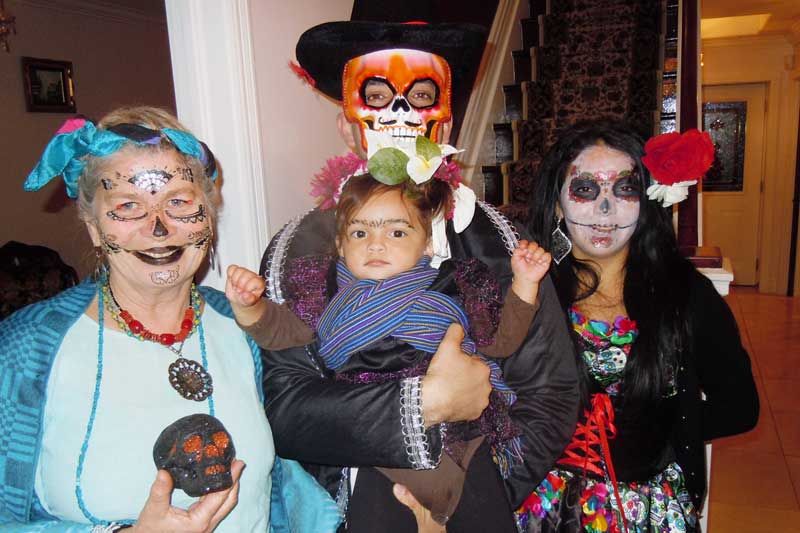Julie Druker | Nov 05, 2015
Those unfamiliar with the lore of Mexico’s Day of the Dead holiday may not have realized that one Sharbot Lake family with roots in Mexico were paying tribute to that country's Halloween traditions. Leslie Johnson, her son Chris, his wife Ana and their daughter Sophia, along with good friend Susan, chose to flavor their Halloween celebrations by honoring the Mexican traditions of the Day of the Dead holiday.
Chris was dressed as a mariachi, a traditional Mexican roots musician, Sophia was dressed as the enigmatic Mexican artist Frida Kahlo, and it was the ladies who put the Mexican tradition of “La Calavera Catrina” to the fore. The ladies wore white skeletal faces, fancy European dress and loads of jewelry reflecting La Calavera Catrina, which translates in English to “dapper skeleton" or "elegant skull".
The image or character comes from a zinc etching created in 1910-1913 by the famous Mexican printmaker Jose Guadalupe Posada, which shows a female skeleton dressed in a fancy hat befitting the upper class European outfits typical of the early 20th century. For the artist, the character represented a satirical portrait of certain Mexican natives who Posada felt were aspiring to adopt European aristocratic traditions in Mexico’s pre-revolutionary era. The name “La Calavera Catrina” is derived from a 1948 work by artist Diego Rivera.
Today La Calavera Catrina remains a popular costume for Mexicans celebrating the Day of the Dead. Thanks to Leslie, Chris, Ana, Sophia and Susan, this Halloween in Sharbot Lake had a unique Mexican flavour to it, likely unbeknownst to the many young trick or treaters who visited their home.
The original leaflet that accompanied the etching described a person who was “ashamed of their Indian origins and instead chose to dress in the French style and to wear white makeup to make his skin look whiter”.
While Posada introduced the character, the popularity of La Calavera Catrina as well as her name is derived from a work by artist Diego Rivera in his 1948 work “Sueño de una tarde dominical en la Alameda Central" (Dream of a Sunday Afternoon along Central Alameda).
The culture of La Calavera Catrina also has deep political associations and has ties to political satire. The original was inspired by the polarizing reign of dictator Porfirio Díaz. Though Diaz' reign modernized and brought financial stability to Mexico, those accomplishments pale in comparison to his government's repression, corruption, extravagance and obsession with all things European and brought extreme wealth to the hands of the privileged few. This in turn brought much discontent and suffering to Mexico and eventually led to the 1910 rebellion that toppled Diaz in 1911 and became the Mexican Revolution.
More Stories
- Latest CUPW Job Action Stops Postal Delivery Of The Frontenac News Forcing Alternate Plans
- Opponents of Barbers Lake Gravel Pit Pack Ag Hall in McDonalds Corners
- Bobsleigh Olympian Jay Dearborn At Mikes Pizza In Sydenham
- The Loins Club Of and O'Lakes Roar
- North Frontenac Back Roads Studio Tour - September 27 and 28
- Sunday Market Vendors Give Back
- George Street Work As Town Hall Renovation Nears Completion
- One Way Street Plan Hits A Dead End - Central Frontenac Council, September 9
- Global Gardening
- No Winner Yet in Catch The Ace But Fundraising Target Met

